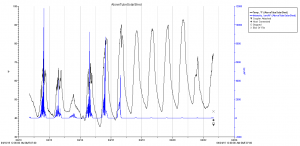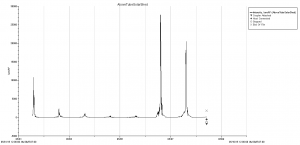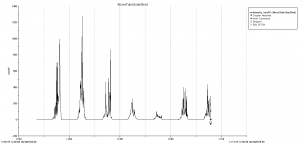Beside the aquaponics greenhouse there is a small shed with a solar tube penetrating the southernmost wall. This solar tube has a dome on the end of the tube outside of the shed. This dome takes in light from all directions and pushes it down the tube. Right below the dome, the inside of the tube is coated with panda film and below the panda film is a six inch aluminum tube. We are collecting data on the light intensity that it being reflected out of the end of the solar tube using a Hobo Pendant that captures light intensity in footcandles. We are also collecting light intensity data outside of the shed just above the solar tube’s dome. Our aim for this solar tube is to find the best way to direct sunlight, so we can give the bottom bed of plants in the aquaponics greenhouse access to more solar radiation. The alternative to this method is buying grow lights and setting them up above the plants. The solar tube method ultimately saves energy as the solar tube requires no energy and just redirects sunlight, but the grow lights require energy to run.
When we first installed the tube, we were getting very low readings for light intensity. We fashioned a twelve inch tube that was coated with panda film. We attached this new tube to the end of the solar tube inside of the shed and, for a while, our readings for light intensity were much greater than without this tube extension. On the 17th of April 2015, our light intensity readings decreased significantly after the twelve inch tube extension was applied. You can see this trend in the graph below.

This is light and temperature data collected from the end of the solar tube, where we’re hoping to push all the solar radiation.
In this graph, the blue line represent light intensity, which is calculated in footcandles (luminosity / feet^2). The black line is temperature. (Later in this blog post you’ll see we stopped recording temperature for the sake of using less space on our hobomonitor device. ) In an attempt to fix the drop in production and to increase the projected luminosity altogether, on May 6th we fashioned a six inch tube out of aluminum with no panda film lining. We’d learned about the fact that telescope mirrors are made of aluminum, so we wanted to see if it would reflect more solar radiation than the panda film. The graph below shows the light intensity at the end of the solar tube before and after attaching the new aluminum tube extension.
You can see that on May 6th, our light intensity readings increase drastically. May 6th was the day that we installed the new six inch aluminum extension to the tube, we can see that it seems to have increased our light intensity readings on both the 6th and the 7th. The plants we intend to grow in the bottom part of the greenhouse bed need a luminosity of about 1,000 footcandles, but our solar tube was giving us an average of about two-hundred. We uninstalled the solar tube and replaced it with a professionally made solar tube in hopes of increasing our luminosity readings. After collecting data on this new tube for two weeks, we’re seeing a small increase in luminosity. We’re hitting our mark of 1,000 footcandles, but only on some very sunny days and we only hit this mark for about 10 minutes each of these days. Although showing improvement, these readings are still too low to be usable for a growing space. The below graph shows the data we collected over the past two weeks.
From this graph you can see that our luminosity spikes at about 1,000, but it only does so for a few minutes at a time. The rest of the time the luminosity readings range between zero and 350. The grow bed we’re trying to illuminate only has luminosity problems during the spring and summer seasons. During these seasons the sun is much higher than fall and winter and the top bed is shading the entirety of the bottom bed. During the fall and winter seasons, the sun is much lower in the sky and generates a good amount of light in the bottom bed, ranging between about 1,000 to 2,000. Since most of our dips in production are on cloudy days and on really sunny days we’re getting a decent amount of solar radiation, the new solar tube should be able to provide us with the luminosity we need during the summer and spring, but during the winter and fall the sun’s angle will provide the luminosity for us.
Our next step is to install our solar tube into the side of the greenhouse and then plant some plants and see how well they grow. If these plants grow well, we’ll install a few more solar tubes to illuminate the remaining dark parts of the bed and increase our greenhouse’s food production.


0 Responses to “Using solar tubes as grow lights”